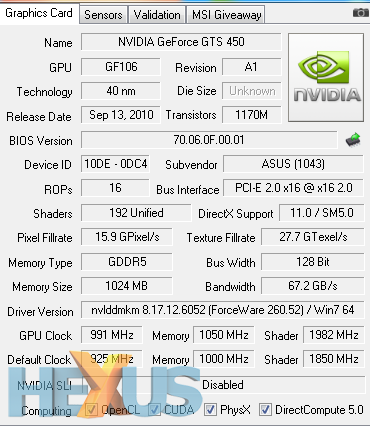HEXUS.bang4buck and HEXUS.bang4watt
Putting it all together, in a rough-and-ready assessment of the cards' bang for buck, we've aggregated the 1,680x1,050 frame-rates for five games, normalised them* and taken account of the cards' prices.
But there are more provisos than we'd care to shake a stick at. We could have chosen five different games, the cards' prices could have been derived from other sources and pricing tends to fluctuate daily.
Consequently, the table below highlight a metric that should only be used as a yardstick for evaluating comparative performance with price factored in. Other architectural benefits are not covered, obviously.
| Graphics cards | ZOTAC GeForce GTX 460 768MB | ASUS GeForce GTS 450 TOP 1,024MB | NVIDIA GeForce GTS 450 1,024MB | HIS Radeon HD 5770 1,024MB | Sapphire Radeon HD 5750 1,024MB | Sapphire Radeon HD 5670 1,024MB |
|---|---|---|---|---|---|---|
| Actual aggregate marks at 1,680x1,050 | 328.7 | 265.6 | 231.9 | 266.4 | 226.4 | 168.7 |
| Aggregate marks, normalised*, at 1,680x1,050 | 280.15 | 227.2 |
186.25 | 235.9 |
183.5 |
109.05 |
| Current pricing, including VAT | £130 | £115 | £99 | £115 | £105 | £85 |
| HEXUS.bang4buck score at 1,680x1,050 | 2.155 | 1.976 | 1.881 | 2.051 |
1.748 |
1.283 |
| Crysis peak power consumption | 204 | 208 | 181 |
163 | 155 | 126 |
| HEXUS.bang4watt** score at 1,680x1,050 | 1.373 | 1.092 |
1.029 | 1.386 |
1.405 |
0.865 |
* the normalisation refers to taking playable frame rate into account. Should a card benchmark at over 60 frames per second in any one game, the extra fps count as half. Similarly, should a card benchmark lower, say at 40fps, we deduct half the difference from its average frame rate and the desired 60fps, giving it a HEXUS.bang4buck score of 30 marks. The minimum allowable frame rate is 20fps but that scores zero.
** the HEXUS.bang4watt score is a crude measurement of how much normalised performance the GPU provides when evaluated against peak system-wide power-draw that's shown on the previous page: the former is divided by the latter. We're using the peak power-draw numbers obtained by running real-world Crysis Warhead.
Evaluation
Our graphs indicate that the GeForce GTS 450 performs much like a Radeon HD 5750 1GB and the ASUS GTS 450 TOP akin to a Radeon HD 5770. The aggregate and normalised numbers bear this out. We see that spending more on a GTX 460 768MB is well worth the outlay and that the performance per watt of the GTS 450 GPUs isn't great.Overclocking
Did we manage to hit the magical 1GHz core frequency? Not quite, as the card topped out at 991MHz core and 4,200MHz memory with voltage set to 1.2V.
Running FurMark to give the GPU some real stick, under-load power-draw increased from an already-high 256W to a potentially noisome 311W, and temps rose from 68°C to 80°C - pushing the cooler near to its limits.
We re-ran the five games at 1,680x1,050 and found that the overclock provided, on average, an extra 5.1 per cent performance over the shipping frequencies.









